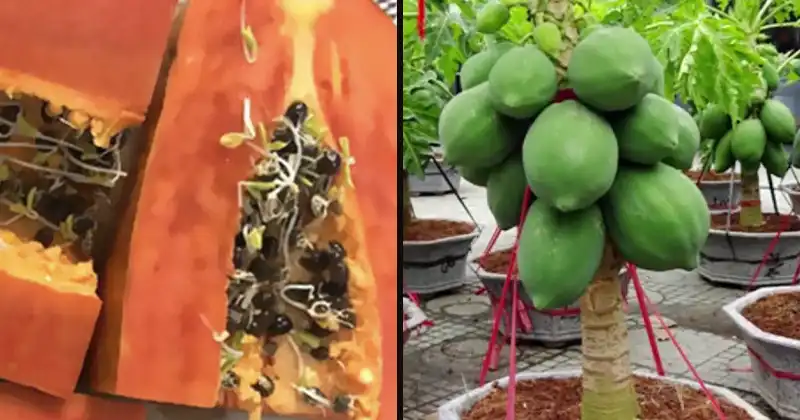Growing papaya at home in pots is an excellent way to enjoy this tropical fruit, even if you don’t have a spacious garden. Papayas are not only delicious but also packed with essential nutrients, making them a valuable addition to your home garden. In this comprehensive guide, we will cover the entire process, from harvesting seeds from another papaya fruit to caring for your potted papaya tree.
Step 1: Selecting Papaya Seeds To start growing papaya at home, you’ll need papaya seeds. These can be obtained from a mature papaya fruit. Here’s how to harvest the seeds:
- Choose a Ripe Papaya: Look for a mature papaya that is fully ripened. The seeds in an underripe fruit may not be viable.
- Scoop Out the Seeds: Cut the papaya in half and scoop out the seeds with a spoon. You can wash them to remove any remaining pulp and let them air dry for a day or two.
Step 2: Germinating Papaya Seeds
Once you have your papaya seeds, it’s time to get them ready for planting. The germination process is crucial to ensure successful growth.
- Moist Paper Towel Method:
- Take a few sheets of damp (not soaking wet) paper towels.
- Spread the seeds evenly on one half of the paper towel.
- Fold the other half over the seeds to cover them.
- Place the paper towel with the seeds inside a plastic ziplock bag.
- Provide Adequate Warmth: Papaya seeds require warmth to germinate. Place the ziplock bag in a warm area (ideally around 75-85°F or 24-29°C) and ensure it receives indirect sunlight.
- Check for Germination: After 1-2 weeks, check the paper towel for germination. Once the seeds have sprouted and have a small root, they are ready for planting.
Step 3: Planting Papaya in Pots
- Select a Suitable Pot: Choose a large pot with good drainage, as papayas dislike waterlogged soil. A pot that is at least 10-15 gallons in size will work well.
- Prepare the Soil: Use well-draining potting mix with a pH of around 6.0-6.5. You can add organic matter like compost to improve the soil’s fertility.
- Transplanting: Gently transplant the germinated papaya seedlings into the prepared pots. Ensure that the top of the root ball is at the same level as the soil’s surface.
- Spacing: If you plan to grow more than one papaya plant, space them at least 10 feet apart to allow for their mature size.
Step 4: Caring for Your Papaya Plant
Growing a healthy papaya plant involves proper care and attention:
- Sunlight: Papayas require full sunlight. Ensure they receive at least 6 hours of direct sunlight daily.
- Watering: Keep the soil consistently moist, but not waterlogged. Water deeply when the top inch of soil feels dry.
- Fertilization: Papayas are heavy feeders. Use a balanced fertilizer or one specifically formulated for fruit trees. Apply it every 2-4 weeks during the growing season.
- Pruning: Regularly trim any dead or damaged leaves and excess growth to encourage a well-structured tree.
- Pest and Disease Control: Keep an eye out for common papaya pests like aphids, mealybugs, and fruit flies. Use appropriate organic pesticides if necessary.
- Support: As the plant grows, provide support to prevent it from toppling over due to the weight of the fruit.
Step 5: Harvesting Papayas
Papayas can take 6-9 months to bear fruit. Harvest the papayas when they have reached the desired ripeness, which is typically when they turn yellow or orange, depending on the variety. Gently twist the fruit from the stem, and it should come off easily.
Growing papaya at home in pots can be a rewarding experience. With proper care and attention to detail, you can enjoy delicious, homegrown papayas even in limited garden space. Remember that papaya plants have a relatively short lifespan, usually around 4-6 years, so be prepared to start the process over when your plant reaches the end of its productive years. Happy gardening!
